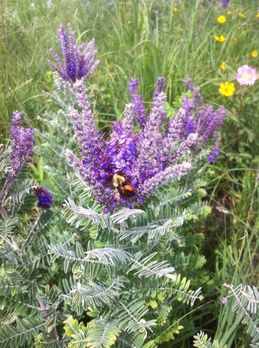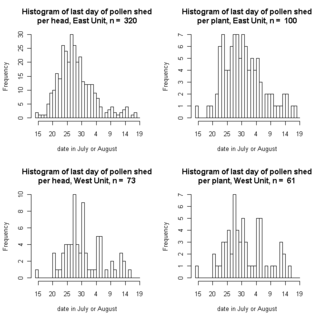|
|
Now that the vast majority of Echinacea are finished flowering (except for the populations at Staffanson and one lonely plant at Northwest of Landfill), I’ve started piecing together a master datasheet with the first and last day of flowering for every Echinacea head that I have been studying. Please let me know if you have any comments or recommendations for statistical analysis, possible comparisons to other data sets, or better organizational methods!
phen_mastersheet_2012.csv
phen_mastersheet_2012_metadata.doc
RAIN!!! After weeks of very little in the way of precipitation, Team Echinacea was rained out on Wednesday morning. Instead of the usual field work and phenology, we worked on data entry and other analyses for our individual projects. Fortunately, it stopped raining around 10 AM and I was able to head out to Staffanson Prairie Preserve to collect data for my phenology project. West Staffanson was burned this past spring and a lot of the plants are flowering later than usual. This rain seemed to have jump started flowering and it seemed like all of West Staffanson went from young, green sprouts to beautiful flowering plants over night. Walking into West Staffanson, I felt like Dorothy entering the land of Oz! Below I’ve attached a few pictures of the flowering plants and pollinators that I saw. Because West Staffanson was burned pretty late in the spring, many of the flowers that have already finished blooming in other remnants were in their prime on Wednesday. In the afternoon, we started working on phenology in Jennifer’s Plot at Hegg Lake.

Allium

An Echinacea on its first day of flowering.

Flowering Amorpha canescens with a pollinator!
This summer I’m going to continue with Amber Z’s phenology research from last year. I’ve added on two new sites: North Northwest of Landfill and Around Landfill. I started taking data on June 18th when there were only a couple of plants beginning to flower, but now, many more plants have started flowering and a couple are even close to finishing!
Kelly’s Flowering Phenology Project Proposal.doc
Hello all! A lot has happened since my last post, so here is a brief update!
After returning to school with my phenology data and experimental seed heads in the fall of 2011, I began work on my senior thesis using that data as a foundation. In April of this year I defended my thesis, “Flowering Phenology and Seed Set in Fragmented Populations of the Prairie Plant Echinacea angustifolia” and was awarded Distinction by my committee! Stuart and I continued to work on my data after my defense and are planning to continue the project and potentially incorporate data from this summer in the hopes of publishing it! Here are some of the very interesting results that we’ve gotten so far:
> aggregate(ss ~ nndist + pdtime, data = mm, mean)
nndist pdtime ss
1 far early 0.1637403
2 near early 0.2690535
3 far late 0.2947009
4 near late 0.1802392
We found that there’s a relationship between seed set (ss), peak flowering date (pdtime), AND distance to the 6th nearest neighbor (nndist). Seed set was higher in plants that had a combination of close 6th nearest neighbor (near) and early peak flowering date or far 6th nearest neighbor (far) and late flowering date. Very interesting!
(table is categorical and matches glm model which looks at pd & nn6 as continuous)
If anyone has any questions, is interested in continuing this exciting project this summer, or would like a copy of my thesis, feel free to contact me! (Amber Zahler at ambermzahler@gmail.com)
Howdy folks! This week field work was delayed by a couple of wet spells, but thanks to reinforcements (thanks Ruth!), we conquered seedling refinds at Loeffler’s Corner on Tuesday; East Riley and Riley on Thursday. Due to lack of time/manpower, we decided to scale back on seedling refinds (by focusing on searching circles that were reported to have at least 1 seedling). The frame maps made using R and the frame coordinates we recorded in June were really helpful.
Yesterday after lunch, the 4 of us (Stuart, Josh, Katherine and I) went out to Hegg Lake. I brought my bike out so I could pull in my Dichanthelium flags from my sites at Hegg Lake, and then I biked to C2 to join in the head harvest. I believe we harvested just over half the heads from C2. After that we headed back to Hjelm House and started harvesting in C1 until it was time to go.
This morning we went out to Staffanson in the truck. Stuart, Josh, and Katherine flagged plants for seedling refinds and harvested Echinacea heads as part of Amber Z’s project. I did my final round of collection at Staffanson and then pulled in flags from the plot that was planted with seedlings in June. After lunch, we paired up and continued harvesting in C1. We filled up NINE grocery bags with Echinacea heads in just one afternoon! Uff da! That was really a heck of a harvest! Good job Team Echinacea!
Echinacea plants on our transect at Staffanson Preserve are done shedding pollen for the year. A few still have persistent, receptive styles, but August 18th was the last day pollen was shed.
This graph show how many heads (left panels) or plants (right panels) finished on each day. The earliest heads finished on 15 July. I divided the preserve according to the burn unit: burned East (top panels) and unburned West (bottom panels):

Final date of flowering for 393 heads on 161 Echinacea plants
from a burned and unburned unit of a prairie preserve
This graph is based on preliminary, raw data, but I wanted to share. Click on the thumbnail to see a larger version of the graph.
|
|




